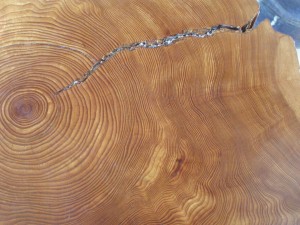17 December 2015
Preserved trees that grew 12,000 years ago improve radiocarbon dating calibrations
Posted by lhwang

Scientists excavated 12,000-year-old logs from a floodplain in New York to improve radiocarbon dating calibrations.
Credit: Carol Griggs.
by Emily Benson
Scientists use radiocarbon dating to determine the age of everything from bone and teeth to seeds and straw. The accuracy and precision of those dates depends on careful calibration. New data from logs unearthed in a small floodplain in New York’s Lake Ontario lowlands will allow scientists to refine the calibrations for a 1,200 year period that occurred about 12,000 years ago, according to Carol Griggs, a dendrochronologist at Cornell University in Ithaca, New York.
The record represents “a new independent radiocarbon series for this time period,” Griggs said at the 2015 American Geophysical Union Fall Meeting in San Francisco.
Atmospheric carbon contains a very small percentage of a radioactive form of carbon, called carbon-14 or radiocarbon. Plants and animals incorporate some of that radiocarbon into their bodies. Because it decays at a predictable rate, scientists can estimate the age of once-living tissue by measuring how much radiocarbon it still contains – the longer it’s been since the plant or creature was alive, the less radiocarbon remains.
The amount of radiocarbon in the atmosphere fluctuates, however, and scientists must account for that variability when using radiocarbon dating. Tree rings contain an annual record of atmospheric radiocarbon, allowing researchers to convert radiocarbon dates to calendar dates if there is a record of living trees or preserved logs as old as the samples they wish to date.
In a new study presented at the meeting, Griggs and her colleagues gathered samples from about 140 logs they uncovered on a farm near Fulton, New York, about half of which turned out to be big enough to analyze. The logs, mainly spruce and larch, were buried about 2.5 to 3 meters (8 to 10 feet) below the surface of a modern-day floodplain.
“It looks like the streambed was just gradually filled in and became a bog,” Griggs said. The trees were not worn smooth, as they might have been if they had washed downstream, indicating they were well preserved and likely grew close to where they were found.
“You still see the root systems, you still see the branches,” Griggs said.
The trees were alive about 11,200 to 12,400 years ago, at the end of the Younger Dryas event and into the early Holocene era, Griggs said.

Tree rings contain an annual record of atmospheric radiocarbon, allowing scientists to calibrate radiocarbon dates and convert them into calendar dates.
Credit: Sheila Miguez, via Flickr, creative commons license.
It’s uncommon to find tree rings that old, said Jennie Zhu, a graduate student at West Virginia University who was not involved in the study. “If you can annually date back to that period, that’s awesome,” she said.
The trees are also unique geographically.
They were collected “in a place where the radiocarbon dating is most questionable,” Griggs said. Previous records of tree ring radiocarbon data from that time period are limited to a single series from central Europe, and two series from the Southern Hemisphere. The data from New York will help scientists understand differences between the Northern and Southern Hemispheres in atmospheric-oceanic radiocarbon exchange, Griggs said.
– Emily Benson is a science communication graduate student at UC Santa Cruz, you can follow her on twitter at @erbenson1 or via her website http://erbenson.com










 GeoSpace is a blog on Earth and space science, managed by AGU’s Public Information staff. The blog features posts by AGU writers and guest contributors on all sorts of relevant science topics, but with a focus on new research and geo and space sciences-related stories that are currently in the news.
GeoSpace is a blog on Earth and space science, managed by AGU’s Public Information staff. The blog features posts by AGU writers and guest contributors on all sorts of relevant science topics, but with a focus on new research and geo and space sciences-related stories that are currently in the news.
Do the rings show of any type of major world wide event that happened 12000 years ago ? There is evidence of many civilizations disappearing around this time thank you.